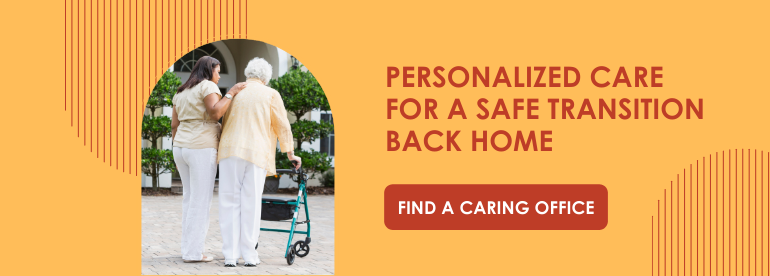After a major illness, injury, or surgery, seniors may go through rehabilitation to help them transition back to daily life safely. Rehabilitation can include physical therapy, speech therapy, occupational therapy, and other forms of treatment. It can be administered in an inpatient or outpatient setting.
Seniors may be referred to inpatient rehabilitation for extensive recovery treatment after a hospital stay. But if a senior only needs rehab a few times a week or less, outpatient rehabilitation could be a great option so a senior can remain at home as they build strength and coordination. Seniors may even be discharged from inpatient rehab to outpatient rehab as they recover. This type of rehabilitation has some definite benefits along with some drawbacks. Let’s dive in and learn more!
Benefits of Outpatient Rehab
Here are some of the benefits of outpatient rehabilitation over inpatient rehabilitation for seniors.
Comfort of home
The biggest benefit of outpatient rehabilitation is perhaps that seniors can remain in their own homes. Most seniors would prefer to stay at home than to be in the hospital or another facility. Home is comfortable and familiar, and it has all the things we use during our daily routine.
In an inpatient rehabilitation facility, a senior may struggle to adapt to their living situation. It can be difficult to downsize and spend so much time away from home. It can also be challenging to share space with other seniors undergoing treatment. This move can cause emotional turmoil and even feelings of helplessness and depression for some seniors.
Flexibility
When going to outpatient rehab, seniors can schedule one or multiple therapy sessions per week as needed to complete their treatment. This schedule is adaptable and can fit into a senior's lifestyle and daily routine.
In an inpatient facility, however, the schedule is not as flexible and may depend on when healthcare providers are available, other patients’ schedules, etc. A senior may be given a schedule and expected to adjust their activities around in, which can disrupt their regular routine.
Limit distractions
When a senior is allowed to go home, they can perform exercises and rest between therapy sessions in a stress-free environment, allowing them to stay focused. In an inpatient facility, there may be many distractions in the surroundings — conversations, television in the background, activities going on. And seniors can’t control or limit these distractions like they can do at home.
Cost
Because seniors are able to live at home for outpatient rehab, the cost is much lower than inpatient treatment. That’s because the bill doesn’t include amenities, meal preparation, round-the-clock nursing care, and other services offered 24/7 at an inpatient facility. When attending outpatient rehab, a senior really only pays for the services that they need to use.
Drawbacks of Outpatient Rehab
Now that we’ve reviewed the benefits of outpatient rehab, let’s turn to some of the drawbacks.
Transportation
One of the main drawbacks of outpatient rehab is that seniors need transportation to get to and from their appointments. Many seniors requiring physical therapy may not be able to drive on their own and will need to rely on others to get to appointments. Their ride may fall through, causing extra anxiety and stress. Additionally, it might be hard to get in and out of a car during recovery.
However, in an inpatient setting, seniors don’t have to travel far for their therapy. And staff can help them get where they need to be within a facility.
Less Support
Seniors attending outpatient rehab may have less support than they would receive in an inpatient rehab program. At an inpatient facility, they would be surrounded by other seniors and medical professionals. Being with seniors who are experiencing the same difficulties can help provide motivation and encouragement. Plus, medical professionals on site can ensure that a senior is doing their exercises, eating regularly, bathing, etc.
At home, a senior may need help from family members or professional caregivers to safely complete their exercises and even activities of daily living since they won't be surrounded by a built-in support system.
Not as intensive
Outpatient rehab is typically not as intense as inpatient rehabilitation. Inpatient facilities have lots of equipment and tools to help seniors in all stages of their recovery. Contrast that to a senior’s home, which likely lacks equipment. However, seniors may be able to purchase some equipment on their own, like resistance bands or assistive devices, to help during their recovery. But the lack of intensive care could be a serious drawback if a senior needs a lot of support and medical attention.
Choosing between Outpatient & Inpatient Rehab
Ultimately, both outpatient and inpatient rehabilitation are great options for seniors. However, one may be a better fit for a senior than the other. We recommend asking the following questions when making your decision.
- What level of care is needed?
- What kind of support is available at home?
- What type of rehabilitation does the doctor recommend?
By considering these questions, you and your loved ones can come to the best decision. If outpatient rehab is right for your senior, know that Caring Senior Service is available to provide extra support as needed. Our caregivers can help prepare the home for a senior’s arrival — tidying up, removing fall hazards, shopping for groceries, etc. And we can motivate and encourage seniors to complete their therapy exercises as prescribed. Reach out to a Caring team near you to learn more.


